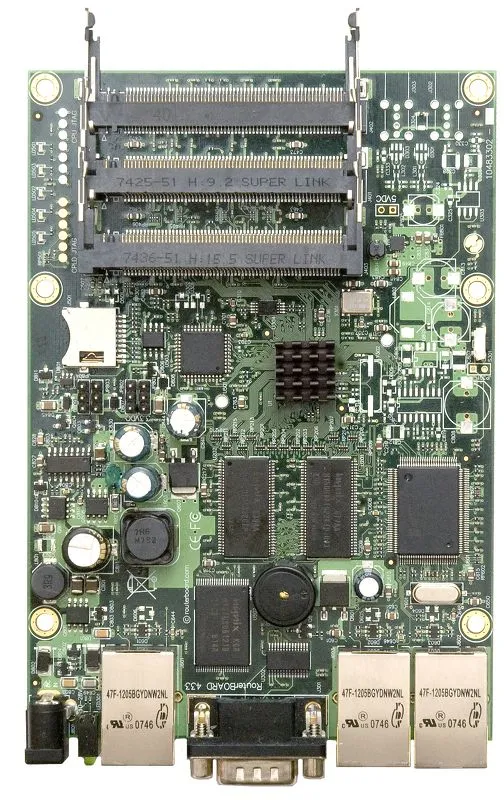MikroTik RB433AH | Router | 3x RJ45 100Mb/s, 3x miniPCI, 1x microSD


Three miniPCI slots and three Ethernet ports provide enough connectors to use the RB433AH as the central part of the network. In addition to our regular RB433 model, the RB433AH version adds more RAM and our popular Atheros 680MHz fast processor, making it an ideal choice for large networks. The microSD card allows you to add more storage for Webproxy cache, logs or VMs

| Features / filters | |
| Number of LAN ports | 3x 10/100BaseTX (RJ45) |
| Additional connectors / interfaces | RS232, 1x microSD, 3x miniPCI, |
| CPU frequency | 680 MHz |
| Management | CLI - Command Line Interface, By web browser, |
| RAM memory | 128MB |
| Type of case | Without enclosure |
| Type of device power supply | Passive PoE, Power supply, |
| Basic technical parameters | |
| CPU | Atheros AR7161 |
| Memory | DDR SDRAM 128 MB |
| Boot loader | RouterBOOT |
| Data memory | 128 MB |
| Ethernet | (3) 10/100 Mbit/s Ethernet ports with Auto-MDI/X function |
| MiniPCI sockets | (3) MiniPCI type IIIA/IIIB sockets |
| Appendices | Switch reset, siren, voltage monitor |
| LEDs | Power supply, NAND activity, 5 user LEDs |
| Power input | PoE input 8-28 V DC on Ether1 (other than 802.3af), Power supply socket (8-28 V DC) |
| Operating temperature | -40° +70°C |
| Dimensions | 105×154 mm |
| Energy consumption | Only 2W, 14W card available on minIPCI cards |
| Operating system | MicroTik RouterOS |
To update your software, you must download the latest package files (*.npk) from our website. Then connect to your router via FTP and upload the new packages to it using the binary transfer mode. Restart your router by issuing the command /system reboot.
When you install RouterOS software or turn on the router for the first time, there are different ways to connect to it:
- Access to command line interface (CLI) via Telnet, SSH, serial cable
- Access to the graphic interface (WebFig)
- Using the WinBox configuration tool (Windows application)
Each router is configured at the factory with IP address 192.168.88.1/24 on Ethernet port1. The default user name is admin without password. After logging in for the first time, please create a new user with the password in group "full". , log in again and delete the default administrator user.
Firewall, Routing, MPLS, VPN, Wireless, DHCP, Hotspot, QoS, Proxy and more.